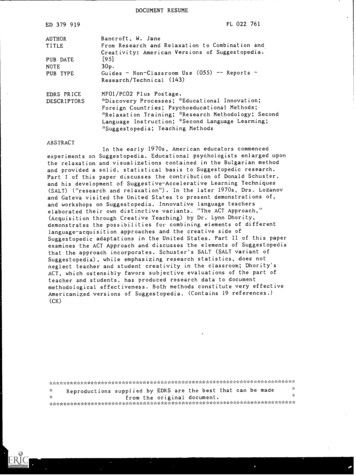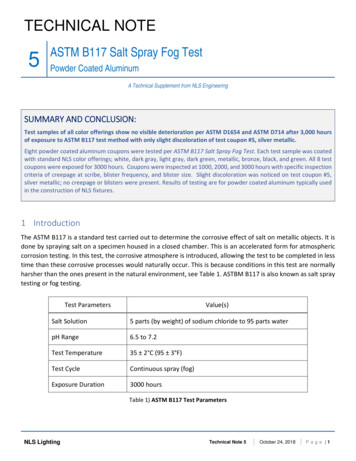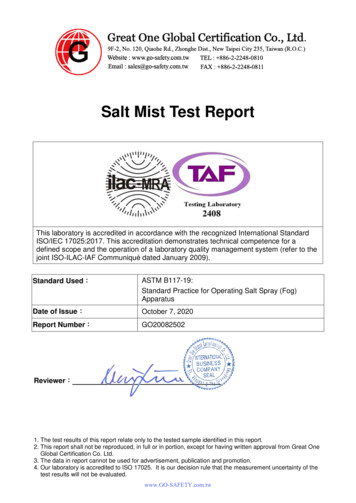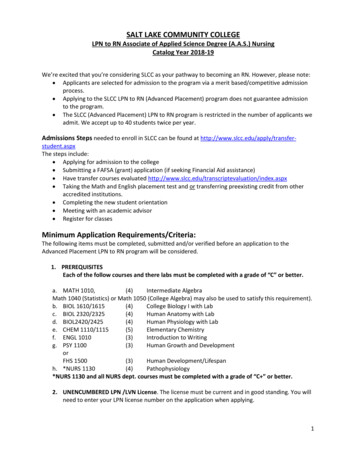
Transcription
DOCUMENT RESUMEFL 022 761ED 379 919Bancroft, W. JaneFrom Research and Relaxation to Combination andCreativity: American Versions of Suggestopedia.AUTHORTITLEPUB DATENOTEPUB TYPEEDRS PRICEDESCRIPTORS[95)30p.Non-Classroom Use (055)GuidesResearch /Technical (143)ReportsMFOI/PCO2 Plus Postage.*Discovery Processes; *Educational Innovation;Foreign Countries; Psychoeducational Methods;*Relaxation Training; *Research Methodology; SecondLanguage Instruction; *Second Language Learning;*Suggestopedia; Teaching MethodsABSTRACTIn the early 1970s, American educators commencedexperiments on Suggestopedia. Educational psychologists enlarged uponthe relaxation and visualizations contained in the Bulgarian methodand provided a solid, statistical basis to Suggestopedic research.Part I of this paper discusses the contribution of Donald Schuster,and his development of Suggestive-Accelerative Learning Techniques(SALT) ("research and relaxation"). In the later 1970s, Drs. Lozanovand Gateva visited the United States to present demonstrations of,and workshops on Suggestopedia. Innovative language teacherselaborated their own distinctive variants. "The ACT Approach,"(Acquisition through Creative Teaching) by Dr. Lynn Dhority,demonstrates the possibilities for combining elements of differentlanguage-acquisition approaches and the creative side ofSuggestopedic adaptations in the United States. Part II of this paperexamines the ACT Approach and discusses the elements of Suggestopediathat the approach incorporates. Schuster's SALT (SALT variant ofSuggestopedia), while emphasizing research statistics, does notneglect teacher and student creativity in the classroom; Dhority'sACT, which ostensibly favors subjective evaluations of the part ofteacher and students, has produced research data to documentmethodological effectiveness. Both methods constitute very effectiveAmericanized versions of Suggestopedia. (Contains 19 references.)(CK)Reproductions supplied by EDRS are the best that can be madefrom the original document.
From Research and Relaxation to Combination and Creativity: American Versionsof SuggestopediaW. Jane Bancroft, Scarborough Campus, University of TorontoAbstractIn the early 1970's, following the publication of the Ostrander-Schroeder PsychicDiscoveries behind the on Curtain, educators in the United States commencedexperiments on Suggestopedia. Educational psychologists most notably DonaldSchuster, Owen Caskey and Allyn Prichard enlarged upon the relaxation andvisualization elements contained in the Bulgarian method (especially its first version)and provided a solid, statistical basis to Suggestopedic research. The results of theirscientific investigations can be seen in their books on the subject of SuggestiveAccelerative Learning and Teaching (or SALT) as well as in their articles in theJournal of the Society for Accelerative Learning and Teaching. The leader in SALTresearch is generally acknowledged to be Dr. Donald Schuster, retired professor ofPsychology at Iowa State University, and Part I of this paper discusses theSchuster/SALT contribution ("research and relaxation") and examines the SALTMethod (or SALT variant of Suggestopedia) as it is described in the Schuster-Grittonteacher's manual, Suggestive-Accelerative Learning Techniques.A second, parallel development occurred in the 1970's, especially following the visitsof Dr. Georgi Lozanov and Evalina Gateva to the United States in the latter part of thedecade to present demonstrations of, and workshops on Suggestopedia.Inspired, in particular, by the artistic qualities of the second (or Gateva) version ofSuggestopedia, innovative language teachers elaborated their own distinctivevariants. With his book, The ACT Approach (for Acquisition through Creative Teaching),Dr. Lynn Dhority, professor of German at the University of Massachusetts, bestdemonstrates not only the possibilities for coinbining elements of different languageacquisition approaches but also the creative side of Suggestopedic adaptations (orapplications) in the United States. Part II of this paper examines the ACT Approachand discusses the elements of Suggestopedia I and 2 which it incorporates.(-6r(-.)---JWhile it may be said that SALT emp asizes scientific research whereas ACT focuseson creativity, the two methods are nc nJtheless complementary. SALT relaxationtechniques are a part of the ACT Approach and Total Physical Response strategies(which, among other communicative-based strategies, are incorporated into ACT) arealso a part of SALT. Schuster's SALT, while emphasizing research statistics, does notneglect teacher and student creativity in the classroom and Dhority's ACT, whichostensibly favors subjective evaluations on the part of teacher and students, hasproduced research data to document methodological effectiveness. In the finalanalysis, it may be said that both methods constitute very effective "Americanized"U.E. DEPARTMENT Of EDUCATION"PERMISSION STO EREPRODUCE THISt:iATERIALversions of SLiggestopedia.Office of Educational Research and improvementDT HBYEDUCATIONAL RESOURCES INFORMATIONCENTER (ERIC)jImsdocument has been reproduced asreceived from the person or otoanuationITf 57ABEST COPY AVAILABLEcDt)c\c,,TO THE EDUCATIONAL. RESOURCESINFORMATION CENTER (ERIC)"4.originating it0 Minor changes nave been made to improveillPrOdUCI.On GUMMYRa its of view Of opinions Stated In trot cloCu-men, 4o not necessarily represent officialOEM pc ',bon or policy
From Research and Relaxation to Combination and Creativity:Rmerican Versions of SuggestopediaW. Jane BancroftPart I:Research and RelaxationIn the early 1970's, following the publication of the Ostrander-Schroeder PsychicDiscoveries behind the Iron Curtain, a number of knowledgeable researchers andeducational psychologists in the United StatesCaskey and Allyn Prichardmost notably Donald Schuster, Owenexpressed interest in, or commenced experiments onSuggestopedia. The circulation of an unofficial English translation of the Lozanovthesis, Sugestologiia, as well as the publication of a number of articles by myself andothers on what was called the Lozanov Method, also stimulated interest and research.Early pilot studies which were published in the newly founded Journal of SuggestiveAccelerative Learning and Teaching (which then became the Journal of the Society forAccelerative Learning and Teaching and now the Journal of Accelerative Learning)showed that Suggestopedia (or what was known of it at the time) held promise. My1975 article, "The Lozanov Language Class," 1 providing details on the first (orNovakovian ) version of Suggestopedia serves as the basis for controlledexperiments conducted by researchers affiliated with the Society for SuggestiveAccelerative Learning and Teaching. (The name was changed in 1980 to the Societyfor Accelerative Learning and Teaching and in 1994 to the International Alliance forLearning). In addition to conducting his own research at Texas Tech University, OwenCaskey supervised theses such as that of Elizabeth Robinett, "The Effects ofSuggestopedia in Increasing Foreign Language Achievement," which showedSuggestopedia had a positive effect on language learning. ("Individual analysis ofachievement revealed that the Suggestopedic approach helped students in the lower
2grade point average ranges more than those with higher grade point averages").2Intheir investigation of the influence of a suggestive atmosphere, synchronized musicand breathing o.1 the learning and 9tention of Spanish words, Ray Borden andDonald Schuster found that, "at a practical level, these variables when presentresulted in learning 2.5 times better than when these same variables were absent." 3In the 1975-76 remedial reading experiments conducted by Jean Taylor and AllynPrichard in Atlanta, 75-80 percent of the pupils gained a year or more on the Spacheoral and silent reading sub-tests after fourteen weeks in the program, only twelve ofwhich were devoted to the actual teaching of reading.4 Researchers generallyconcluded that three elements of Suggestopedia were essential for the system towork effectively in an American setting: I) an attractive classroom (with soft lighting)and a pleasant classroom atmosphere; 2) a teacher with a dynamic personality, ableto act out the material and motivate the students to learn; 3) a state of relaxed alertnessin the students.5By the time Dr. Lozanov came to lecture to the members of the Society forAccelerative Learning and Teaching in the late 1970's, the Suggestopedic methodhad changed. Instead of presenting the Novakov version ( Suggestopedia 1) whichwas largely based on yoga, Lozanov and his new assistant, Evalina Gateva,presented a somewhat different version, one VIM was more artistic, but which wasdeprived of many of the earlier, yogic memorytraining and relaxation elements.Researchers subsequently took up elements of the Gateva version (Suggestopedia 2)but also retained elements of the former version (as it had been described in myarticle "The Lozanov Language Class" ). More importantly, howevP-, they greatlyenlarged upon the relaxation and visualization elements as well as the positive
3suggestions for pleasant learning contained in the two versions of Suggestopedia,modified Bulgarian language programs to appeal to an American audience andcreated "suggestopedic" programs for a wide range of school and college subjects. inaddition (and in contrast to Lozanov himself), they provided a solid, statistical basisfor Suggestopedic research. The results of the research of Owen Caskey, DonaldSchuster and Allyn Prichard can be seen, not only in their articles in the Journal of theSociety for Accelerative Learning and Teaching but also in their books on the subject:Caskey's Suggestive-Accelerative Learning and Teaching; Schuster's SuggestiveAccelerative Learning Techniques Prichard's Accelerating Learning: the Use ofgestion in the Classroom.6While the work of all three researchers in Suggestopedia and/or SALT has beenimportant, the leader in Suggestive-Accelerative Learning and Teaching (or SALT)research is generally acknowledged to be Dr. Donald Schuster, retired professor ofPsychology at Iowa State University, founder and longtime editor of the SALT journaland trainer of hundreds of teachers in SALT strategies. Let us now focus on the SAL TMethod (or SALT variant of Suggestopedia) as it has been described in Dr.Schuster's many articles and, most particularly, in the book which he co-authored withCharles Gritton, Suggestive-Accelerative Learning Techniques. (An earlier versionwas the SALT manual of classroom procedures based on the Lozanov Method)Suggestive-Accelerative Learning and Teaching (or SALT)In the introduction to the Schuster-Gritton book, we find the following definition ofthe Suggestive-Accelerative Learning Techniques (or SALT) Method:[It] uses aspects of suggestion similar to advertising and unusual styles of presenting material to accelerate classroom learning. The essence of this techniqueis using an unusual combination of physical relaxation exercises, mental concentration and suggestive principles to strengthen a person's ego and expand his
4or her memory capabilities while material to be learned is presented dynamicallywith relaxing music. 7According to Schuster, Dr. Lozanov was the first to put all of these componentelements together in "an integrated and highly effective learning procedure," viz.Suggestopedia (p. 1).The SALT Method incorporates (and, indeed, elaborates upon) the basictheoretical elements of Suggestopedia 1 (authority, infantilization, double-planeness,intonation, rhythm and concert pseudopassivity) as well as the three principles ofSuggestopedia 2: joy and absence of tension and concentrative psychorelaxation;the unity of conscious and paraconscious and integral brain activity (i.e., whole-brainlearning); the suggestive link on the level of the reserve complex. (Suggestion is usedto tap the normally unused reserves of the mind for increased learning). Thesuggestopedic means of version two (psychological, didactic and artistic) are also apart of the SALT Method.In addition to providing more detailed information on the ways of using suggestionin the classroom, the Schuster-Gritton book, influenced by Milton Erickson, goes intogreater depth than Lozanov's on the theoretical aspects of suggestion. As opposed tothe commonly accepted technical definition of suggestion, i.e., the transmission orinfluence of ideas and their uncritical acceptance by the recipient, Schuster prefers a"humanistic" definition, viz. suggestion as indirect communication, indirection, hintingor intimating. Suggestion in the SALT Method is closer to suggestion as used inadvertising or in the arts.In the SALT classroom, suggestion may be direct or indirect;verbal or nonverbal. Verbal suggestion may be direct (as in "learning will be easy foryou today") or indirect (as in a question such as "Are you willing to find that out [withrespect to today's lesson]?" or a truism such as "Sooner or later you are going to do6
5extremely well in class") (pp. 63 ff). Direct nonverbal suggestion comprises gesturesand mime to get students to imitate the teacher; indirect nonverbal suggestionincludes eye contact, manner of speaking, physical posture and location while talkingin class (with reference to the teacher); peer success and peer pressure (withreference to the students); and the environment (with reference to the classroom).Regarding environmental nonverbal indirect suggestion, such elements as asemicircular arrangement of chairs, light colors, soft lighting and relaxing backgroundmusic are important as they make the classroom more inviting for the students.Suggestion in both Suggestopedia and the SALT Method also involves desuggestion and the overcoming of barriers that interfere with teaching and/or learning.Lozanov's barriers to communication, teacher-student interaction and acceleratedlearning (viz. moral-ethical, rational-
In the early 1970's, following the publication of the Ostrander-Schroeder Psychic Discoveries behind the Iron Curtain, a number of knowledgeable researchers and educational psychologists in the United States most notably Donald Schuster, Owen Caskey and Allyn Prichard expressed interest in, or commenced experiments on Suggestopedia. The circulation of an unofficial English translation of the .











